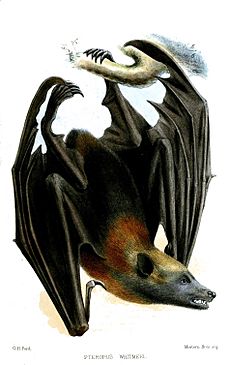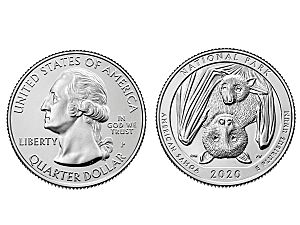Samoa flying fox facts for kids
Quick facts for kids Samoa flying fox |
|
|---|---|
 |
|
| Samoa flying fox in the wild | |
| Conservation status | |
| Scientific classification | |
| Genus: |
Pteropus
|
| Species: |
samoensis
|
 |
|
| Samoa flying fox range | |
The Samoa flying fox (Pteropus samoensis) is a type of large bat. It belongs to a group called "flying foxes" because their faces look a bit like foxes. You can find this special bat in places like American Samoa, Fiji, and Samoa. In Samoa, people call it pe'a or pe'a vao. These bats naturally live in warm, dry forests. Sadly, they are in danger because their homes (habitats) are being destroyed.
Contents
About the Samoa Flying Fox
The Samoa flying fox is a medium-sized bat. It usually weighs about 450 grams, which is less than a pound. Its wings can spread out to about 0.86 meters wide, which is almost three feet! This bat has a face that looks like a fox, with a pointy nose. Its body and wings are brown, but the fur on its head and shoulders is a lighter color, like blond or silvery-grey.
Where They Live and Their Homes
The Samoa flying fox is originally from Fiji, Samoa, and American Samoa. These bats live in different kinds of forests, both old and new. They can also be found in farms, areas with mixed trees and crops, and even near villages. Unlike many other flying foxes, this species often rests alone or in small family groups.
Life and Habits
This bat is mostly active during the day. It flies out to find food in the early mornings and late afternoons. The Samoa flying fox mainly eats fruit. However, it also enjoys leaves, flowers, and sweet nectar from plants.
Scientists believe these bats are monogamous, meaning a male and female stay together. The male bat protects a large area of about 3 square kilometers (about 1.1 square miles). A single baby bat is usually born once a year, often in May or June. Young bats start flying when they are about half the size of their parents. They might still depend on their mothers until they are about three-quarters of her size.
Their Status and Protection
The IUCN lists the Samoa flying fox as "Near Threatened". This means their numbers are slowly going down. However, they live in a wide area and are still quite common in those places. The decline is not fast enough to put them in a more serious danger category right now.
The biggest problems for these bats are forests being cut down and people hunting them for food. In the 1980s, many bats were hunted to be sold as a fancy food. But in 1990, a rule was made to stop this trade. The Samoa flying fox was added to Appendix I of CITES. This made it illegal to sell or export them internationally. Since then, hunting has been on a smaller scale, mostly for local use. Some national parks and protected areas also help keep these bats safe.
Samoan Stories and Legends
The Samoan word for the flying fox, pe'a, is also the name of a traditional Samoan male tattoo. In stories and legends from Samoa and other Polynesian islands, the flying fox is often mentioned.
One famous story from the island of Savai'i in Samoa tells about Nafanua, the goddess of war. She was saved by flying foxes when she was stuck on a difficult island. This shows how important these creatures are in their culture.
The 2020 American Samoa Quarter
In 2018, the U.S. Mint created designs for the 2020 America the Beautiful National Park of American Samoa Quarter. This coin has the familiar image of George Washington on one side. The other side of the quarter shows a Samoan fruit bat mother hanging in a tree with her baby.
This image highlights how much care and effort these bats put into raising their young. The design also aims to make people aware that this species is threatened. They are in danger because their homes are disappearing and because of hunting. The National Park of American Samoa is the only park in the United States where you can find the Samoan fruit bat.
Richard Masters, an art professor, designed the bats on the coin. Different committees chose these designs. The coin was released to the public in February 2020. It was one of several special quarters released that year.
See also
 In Spanish: Pteropus samoensis para niños
In Spanish: Pteropus samoensis para niños




